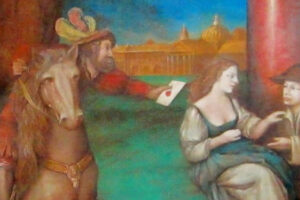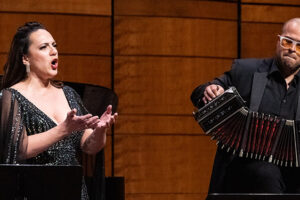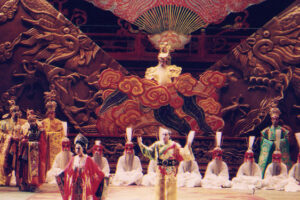

“All right, I’m ready for my closeup.”
A Met HD cinema broadcast of Puccini’s Tosca on Saturday, 27 January, concluded the first run of a production marked by upheaval in the ten months between its announcement and its New Year’s Eve premiere. For readers who have been in a cave meditating—and have made an unfortunate choice of reading material upon their reemergence—none of the three originally scheduled star singers was still attached by opening night. Conducting duties had been twice reassigned, with the second conductor’s removal connected to lurid headlines.
As I had expected, the scripted copy for the broadcast’s hostess, mezzo Isabel Leonard, downplayed behind-the-scenes drama. The audience was reminded only that the lead soprano had agreed to step into the production on “short notice,” and that she was singing her first-ever Toscas on an accelerated schedule.
If history is any guide, ousted music director emeritus James Levine would have been the subject of a coaxed testimonial from every singer and maybe some orchestra members had his accusers kept quiet and he had conducted this performance.
As things stand, his image has even been scrubbed from the Bloomberg sponsorship montage (“We share a passion for drama”) that opens HD broadcasts. In the #metoo remix, his place has been taken by music director designate Yannick Nézet-Séguin. Nothing and no one is irreplaceable.
Where the productions of Franco Zeffirelli are concerned, many Metgoers may beg to differ. To them, two hundred opportunities over 21 years to see the Italian director’s Reagan-era scenic spectacular were not sufficient.
The rather timid provocations of a muddled 2009 Luc Bondy replacement (the late Bondy’s only Met work, unfortunately) offended traditionalists, and the Bondy Tosca never inspired much of a “pro” contingent to argue with the “anti” one. If you did not hate it, you probably were moved to no more passionate a declaration than “I don’t mind it.”
Bondy’s unloved effort got the broom at just shy of 60 performances, and GM Peter Gelb ordered up a new Tosca from a reliable hand. Scottish director David McVicar, whose ninth Met production this is, occupies a position in the present order similar to Elijah Moshinsky‘s with the Joseph Volpe regime.
Both of these Anglos are intelligent professionals who have the measure of the house and can get a show in on time and on budget. Neither does work that is likely to shake anyone up. Some of McVicar’s early, pre-Met work was mildly controversial, but those days now seem very distant.
I should disclose that I was never among the admirers of the Zeffirelli Met Tosca. The day before seeing the HD, I revisited the DVD of the 1985 performance with its premiere cast, and found that time had not moved the needle. I still found it overblown, cynical, heedless of logic. It came from past the point when Zeffirelli’s impulses had become primarily decorative, as he put big-donor bucks toward repeating himself in ever-gaudier excess.
McVicar and set/costume designer John Macfarlane have better taste than Zeffirelli had by the mid-1980s, but the shadow of Zeffirelli’s Met production hangs over theirs. Both productions are cluttered with supers. Both have a fire blazing in the fireplace of Scarpia’s study (in June, in Rome). Both aspire, at the start of Act Three, not to atmosphere but to long minutes of irrelevant, overpopulated “business.”
“Non mi ravvisate? Il carcere m’ha dunque assai mutato?” Angelotti asks of Cavaradossi in the first act. In both productions, the bass singing Angelotti looks so healthy, rested, well dressed and well groomed that the question is puzzling. In McVicar’s, I can only assume Angelotti was clean-shaven before his ordeal. Now he has a neatly trimmed beard.
McVicar does seem to have made choices in consideration of his changing premiere cast. I believe there are interactions here he might have directed differently with, for example, a more mature Tosca or a younger, more magnetic Scarpia. But the overriding impression is of neutrality, which is both a strength and a weakness.
It is a production I expect to hold up well, as they say, and to serve the Met for longer than its immediate predecessor did. New singers will fit into it and fill its spaces with their interpretations. Macfarlane’s opulent yet smartly scaled sets will remain, as will most of his costumes. A different Tosca may get an Act Two gown with a less revealing cut than the one the present soprano wears.
Presumably, the 200+-minute run time of a broadcast with two hours of music was a case of the Met taking advantage of a large audience for leisurely promotions (of L’elisir d’amore and Semiramide), rather than of interminable intermissions being necessary for this Tosca. The run time listed on the Met’s website is more sensible, under three hours.
Some reviewers have noted that nothing in the production is “revelatory.” I am not sure that that would be possible with this work in 2017-18, for those of us who have seen our share of Toscas. I no longer expect Tosca to give up secrets. I feel I am seeing a great Tosca when it grips me, and even though I know everything that is going to happen next, the singing actors almost fool me that they do not.
At the levels of suspense, intrigue, lifelike detail, and getting everything possible out of what Puccini, Sardou, Illica and Giacosa provided, this is not a remarkable Tosca. It settles for being handsome, diverting and straightforward.
Its greatest onstage asset is its leading lady. The daring Sonya Yoncheva is presently much in demand. When she agreed to add Tosca to her 2017-18 Met workload, following Kristine Opolais‘s departure, it put her in three of ten scheduled HD broadcasts. She is at the point in her career where people complain about overexposure and “worry” (sincerely or otherwise) for her vocal longevity.
I can only say that I have seen and heard her in a number of more and less congenial roles now, and I respect and appreciate her commitment to bringing characters to life in her dramatic response and her shaping of music. She does not coast.
Much of what Yoncheva does here is interesting and well considered. Her Tosca in the first act is longer on seriousness than either hauteur or feminine charm. She is irritable, and one senses the irritability is rooted in insecurity. “Tornalo a dir!” is not imperious; there is a fearful edge to it. This is a young diva, a little harried and flustered, and her Cavaradossi is not so suave in his handling of her. He communicates that she can be wearying, but she is worth the trouble.
Yoncheva’s progression through the drama of Act Two has persuasive detail. She takes care to mark each stage as Tosca apprehends (as much as she is going to) how much trouble she and Cavaradossi are in, and how high the stakes are in a world previously unknown to her. The soprano surprises with a rich lower register; there is shine and clarity to the middle, and the top, never a glory, is creditably negotiated. “Vissi d’arte” is poised, with fine legato.
One of the production’s most distinctive (and timely) touches is the graphic nature of Scarpia’s pawing of the heroine, and this time there is no ambiguity in Tosca’s response, no subterranean erotic charge between them. She finds him repellent. Although the prop knife is poorly chosen (more an issue in an HD broadcast than it would be in the house), the murder is well staged. Scarpia is plausibly caught off guard; Tosca’s knife thrust is quick and savage, and the heroine does not stop at inflicting one wound.
This is also a cannier Tosca than some. “Io già raccolsi oro e gioielli,” she sings to Cavaradossi in the third act. Sometimes the line sounds as though it is coming from a diva unable to part with accumulated luxuries—a cousin to the same composer’s materialistic Manon Lescaut, who lingers to her undoing. Yoncheva’s Tosca is obviously concerned with survival, her own and Cavaradossi’s, and with gathering what she can sell to make that easier.
Vittorio Grigolo is a singer who “shows up,” in both senses. He is not prone to cancel, and he has a born performer’s zeal and a corresponding lack of inhibition. I have found his performances of French tenor roles in recent Met and ROH seasons stylish and charming, but his Cavaradossi is a less happy encounter.
This time all the high-energy carrying on seems in the service of compensating for a voice too slight to fill out the music ideally. Grigolo sounds at or near his limit much of the time; one is aware of tonal restrictions. While he makes it through and does not embarrass himself, it is not a performance I would enjoy hearing on a recording or a radio broadcast.
I could admire Zeljko Lucic‘s workaday Scarpia in no circumstances. McVicar aims for understated menace rather than italicized villainy with this character, but in both vocal and dramatic terms, Lucic plods through a familiar part, conjuring an unpleasant functionary.
There is little to note in the way of profile or memorable engagement with the other singers. Lucic does not even bother to moderate his breathing while playing dead on camera. Even under broadcast conditions, his roughening baritone is underpowered, occasionally covered by the orchestra, notably in Act One’s massive Te deum.
Best of the others is Christian Zaremba‘s Angelotti, a promising house debut. Lines are nicely etched in a good firm sound, and the bass brings some presence to his brief role, even if I feel McVicar and Macfarlane have him looking too well turned out to convey a fugitive’s desperation. Patrick Carfizzi, a young singer for the Sacristan (frequently a “welfare role”), seems to be going for a distracted delivery –an interesting idea—but landing at lack of focus.
Emmanuel Villaume made his Met debut in a Puccini opera (a 2004 revival of the Giancarlo del Monaco Madama Butterfly with Kallen Esperian and Roberto Aronica), but has proved more valuable in recent seasons as a specialist in French repertoire.
Although the HD performance is a considerable improvement on the disheveled opening-night live stream, and the orchestra plays the familiar score as well as one would expect a first-rate orchestra to do, it cannot be said that the reading is special in matters of momentum, integration and finish.
In interview with hostess Leonard, Yoncheva is thoughtful, absorbed in requirements of the role of the day. Grigolo is manic and discursive on the subject of his past and present career (he once sang the shepherd boy with Luciano Pavarotti‘s Cavaradossi). Lucic is stiff, difficult to pry anything out of, and what he does venture is not illuminating.
In other words, the interviews line up well with the performances. Designer Macfarlane appears in a taped segment and says things that will please and reassure theatrical conservatives in the Met’s audience base.
The year does not begin with one of the series’ great broadcasts (among those I would include the 2o17 Rosenkavalier, the 2016 Elektra, the 2013 Parsifal and Falstaff, the 2007 Eugene Onegin), but I would go more often if this Tosca represented the lowest level. I took my aunt, who had attended and disliked one live opera about 40 years ago, and had not been aware of the Met HD series.
She loved everything about the Tosca, especially Ms. Yoncheva’s performance, and commented that being able to see the singers’ expressions and to read the subtitles made the experience more engrossing for her. She also enjoyed intermission clips of Matthew Polenzani, Pretty Yende, Ildebrando d’Arcangelo and Angela Meade in upcoming operas.
I had expected exactly this reaction, and thus believe I made appropriate use of a good introductory-level production of a good introductory-level opera.
Ms. Yoncheva and Messrs. Grigolo, Lucic and Villaume have completed their allotment of Toscas for the season. Spring performances of the McVicar/Macfarlane production, with a new cast and conductor, begin at the Met on April 21.
Saturday’s HD will repeat in participating theaters at 1:00 and 6:30 p.m. on Wednesday, January 31. Consult your local listings, and if you go, take someone new along with you.
Photo: Ken Howard
























Comments